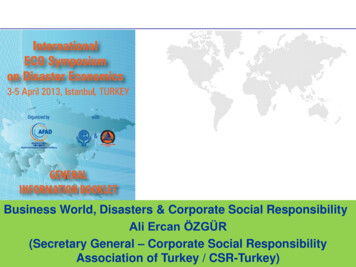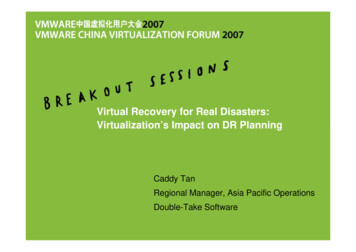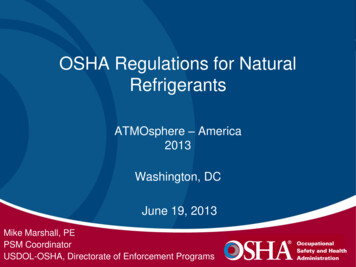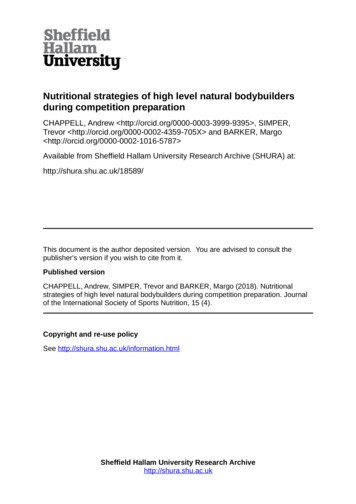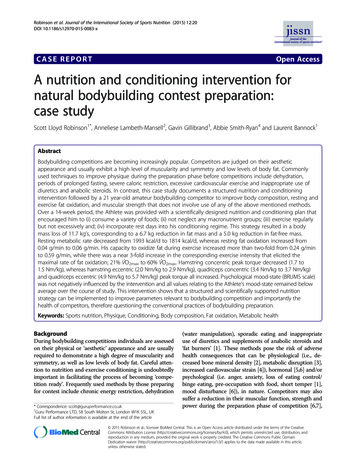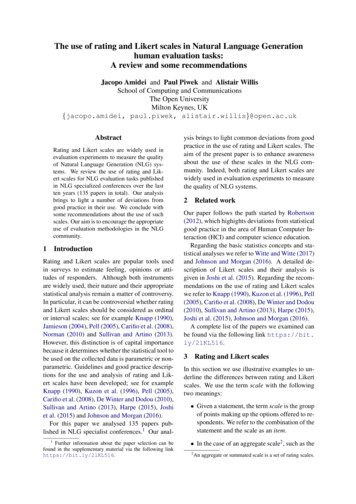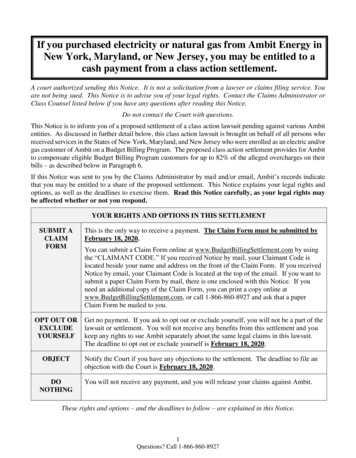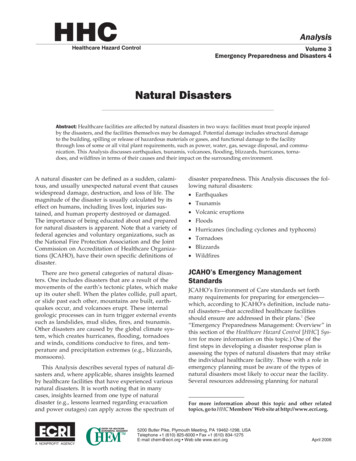
Transcription
HHCAnalysisHealthcare Hazard ControlVolume 3Emergency Preparedness and Disasters 4Natural DisastersAbstract: Healthcare facilities are affected by natural disasters in two ways: facilities must treat people injuredby the disasters, and the facilities themselves may be damaged. Potential damage includes structural damageto the building, spilling or release of hazardous materials or gases, and functional damage to the facilitythrough loss of some or all vital plant requirements, such as power, water, gas, sewage disposal, and communication. This Analysis discusses earthquakes, tsunamis, volcanoes, flooding, blizzards, hurricanes, tornadoes, and wildfires in terms of their causes and their impact on the surrounding environment.A natural disaster can be defined as a sudden, calamitous, and usually unexpected natural event that causeswidespread damage, destruction, and loss of life. Themagnitude of the disaster is usually calculated by itseffect on humans, including lives lost, injuries sustained, and human property destroyed or damaged.The importance of being educated about and preparedfor natural disasters is apparent. Note that a variety offederal agencies and voluntary organizations, such asthe National Fire Protection Association and the JointCommission on Accreditation of Healthcare Organizations (JCAHO), have their own specific definitions ofdisaster.disaster preparedness. This Analysis discusses the following natural disasters:There are two general categories of natural disasters. One includes disasters that are a result of themovements of the earth’s tectonic plates, which makeup its outer shell. When the plates collide, pull apart,or slide past each other, mountains are built, earthquakes occur, and volcanoes erupt. These internalgeologic processes can in turn trigger external eventssuch as landslides, mud slides, fires, and tsunamis.Other disasters are caused by the global climate system, which creates hurricanes, flooding, tornadoesand winds, conditions conducive to fires, and temperature and precipitation extremes (e.g., blizzards,monsoons).JCAHO’s Emergency ManagementStandardsThis Analysis describes several types of natural disasters and, where applicable, shares insights learnedby healthcare facilities that have experienced variousnatural disasters. It is worth noting that in manycases, insights learned from one type of naturaldisaster (e.g., lessons learned regarding evacuationand power outages) can apply across the spectrum of· Earthquakes· Tsunamis······Volcanic eruptionsFloodsHurricanes (including cyclones and typhoons)TornadoesBlizzardsWildfiresJCAHO’s Environment of Care standards set forthmany requirements for preparing for emergencies—which, according to JCAHO’s definition, include natural disasters—that accredited healthcare facilitiesshould ensure are addressed in their plans.1 (See“Emergency Preparedness Management: Overview” inthis section of the Healthcare Hazard Control [HHC] System for more information on this topic.) One of thefirst steps in developing a disaster response plan isassessing the types of natural disasters that may strikethe individual healthcare facility. Those with a role inemergency planning must be aware of the types ofnatural disasters most likely to occur near the facility.Several resources addressing planning for naturalFor more information about this topic and other relatedtopics, go toMembers’ Web site at http://www.ecri.org.5200 Butler Pike, Plymouth Meeting, PA 19462-1298, USATelephone 1 (610) 825-6000 Fax 1 (610) 834-1275E-mail chem@ecri.org Web site www.ecri.orgA NONPROFIT AGENCYApril 2006
Healthcare Hazard Controldisasters are available elsewhere in this section of theHHC System.As required by standard EC.4.10, healthcare facilities must conduct a hazard vulnerability assessment toidentify the types of natural disasters for which the facility is at risk. Once this is done, it must be ensuredthat the facility’s emergency preparedness plan outlines response procedures for these types of naturaldisasters. The facility should incorporate naturaldisaster scenarios into its drills.Effect of Natural Disasters on HealthcareFacilitiesThe impact of natural disasters on healthcare facilitiesis manifold. First, facilities must treat an influx of patients injured by natural disasters, attending to thelong-term health risks caused by disruption of community water and sanitation services as well. Theymay also end up providing emergency shelter formany people.Second, the facilities themselves may be directly orindirectly affected by the disaster. Direct effects frombeing “hit” could include structural damage to thebuilding, injury to the occupants of the building, spilling or release of hazardous materials or gases, andfunctional damage to the facility, including loss ofsome or all plant functions, power (backup emergencygenerators may not work if they are underwater orhave been blown off the roof), water, gas, sewage disposal, and communication lines. The loss of powerand water also affects such things as the heating andventilation systems and the production of steam forsterilization.Indirect effects on a healthcare facility include thedestruction of the entire infrastructure surrounding it,which may not have been taken into account when theemergency response plan was created. The hospitalshould be prepared to think of itself as an isolated island for some time. In retrospect of 2005’s HurricaneKatrina, many healthcare facilities along the GulfCoast emphasized the need to be prepared to operatein disaster mode for longer durations than may be expected. Roads and bridges may be out, making it impossible for staff to get in and out or for standingorders for tanks of water or other necessary suppliesto be delivered. Refuse and hazardous/medical wastepickup may not be possible. Fire and police departments, which might normally be part of a facility’semergency response plan, will have their attentionelsewhere.2Emergency Preparedness and Disasters 4Finally, a natural disaster with wide-reaching impact may force healthcare facilities to set up temporary clinical unit locations, temporary triage areas,temporary morgues, and support services.2EarthquakesIssues for Healthcare FacilitiesThe 6.7-magnitude earthquake that occurred in 1994in Northridge (near Los Angeles), California, resultedin the evacuation of eight healthcare facilities; four ofthese facilities sustained such extensive damage thatthey eventually were demolished. Interestingly, twofacilities resumed full operation before they were ultimately condemned for being unsafe due to previouslyunidentified structural damage,3 highlighting the needfor careful, expert evaluation of structural safetybefore occupancy is resumed.Facilities that evacuated patients cited the followingreasons:· Water damage from burst pipes, fire sprinklers, andruptured rooftop water tanks· Loss of electrical power· Inability to provide medical care because of inoperative ventilation and fire-suppression systems anddestruction of medical supplies or equipmentWhat Is an Earthquake?An earthquake is a sudden shifting of the earth, usually at a fault—a fracture or fracture zone where displacement of the crust occurs. Faults commonly formdue to forces created by tectonic plate collisions, divergence, and sliding. While faults often occur at plateboundaries, these forces can also cause faults to formfar from boundaries. As movement occurs, the piecesof the crust press against each other, causing stressand strain. This in turn is thought to cause the actuallength of the rock to change by causing it to bend andstore energy, almost like a stretched elastic band. Atsome point, the stress level overcomes the frictionalresistance, the rocks crack, and there is a sudden slip.4Not all geologists agree with this elastic-reboundtheory of earthquakes; nonetheless, all models agreeon one point: something comes between the sides ofthe fault and lubricates them, making the fault weak.5Action at the faults produces vibrations called seismicwaves or tremors, which radiate out in all directions.Not all rocks rebound immediately, so slippage is notalways associated with an actual earthquake. 2006 ECRI. May be reproduced by member institution only for distribution within its own facility.April 2006
Emergency Preparedness and Disasters 4Measuring EarthquakesThe size of an earthquake is usually measured by itsmagnitude (which is measured using the Richterscale), which relates to the amount of energy released.The shaking of the earth is recorded by a seismographand is converted to magnitude using logarithms,meaning that an increase of one in magnitude translates to a tenfold increase in amplitude of shaking.Magnitude also relates generally to the damage expected; a 5-magnitude earthquake can cause moderatedamage, a 6-magnitude earthquake can cause considerable damage, a 7-magnitude earthquake is a majorearthquake capable of causing widespread damage,and an earthquake of magnitude 8 or greater is considered to be catastrophic. Also, a higher-magnitudeearthquake will last longer and produce more shakingthan a lower-magnitude one. Other factors that mayaffect the damage caused by an earthquake includethe location of the quake’s epicenter, which is at thesurface of the earth directly above the focus of theearthquake, and the type of rock that is involved.Effects of EarthquakesIt is sometimes said that “earthquakes don’t kill people; buildings do.”6 The primary effect of earthquakesis vibration and shaking of the ground, including permanent displacement of ground. This displacement, inturn, causes the most damage to buildings, bridges,dams, tunnels, pipelines, and other structures. Long,lower-frequency shock waves lasting several tens ofseconds cause more damage to buildings than short,sharp waves with higher frequencies because eventhough a building may withstand the initial quake,the longer shaking causes the ground to liquefy, making it unable to support the structure.7Liquefaction usually occurs on silty or sandy soilswith a high water content or where the groundwatertable is near the surface, usually within 30 feet. Theyounger and less consolidated the soil and sedimentsand the shallower the water table, the greater the liquefaction risk. The continuing vibrations move thewater through the soil toward the surface, ultimatelymaking the soil more liquid and often, in effect, boiling the sand and shooting fountains of water and sediment out. The land no longer has the strength tosupport buildings, and they collapse. Unfortunately,many of the major cities of the world are partly builton such sediment.8Secondary effects associated with earthquakes include broken gas and water lines, fires (which are often started from damaged gas lines and may be evenApril 2006Healthcare Hazard Controlharder to put out than usual because water mainsmay also be broken), chemical and radioactive material releases, landslides, tsunamis, and floods. Landslides occur when rocks fall and slides of rockfragments occur on steep slopes. Electrocution,drowning, and respiratory disease from exposure todust, rubble, and asbestos are among the healthhazards associated with earthquakes.Location of Most EarthquakesThe areas in the United States that fall within the Ringof Fire—that is, the West Coast, particularly sections ofsouthern California and western Nevada—account for90% of all seismic activity in the United States.9 However, 39 states are considered to include areas that facea moderate to major threat of a major earthquake.10 (See“Figure 1. Earthquake Risk Areas in the UnitedStates.”) Furthermore, a set of maps released by theU.S. Geological Survey (USGS) also shows an increasedawareness of the high threat of earthquakes in the Pacific Northwest, the central United States (near the NewMadrid Fault Zone), and regions affected by the Yellowstone hot spot (Idaho, Montana, and Wyoming).11Other lesser-known areas east of the Rockies that USGSconsiders to be at risk include Connecticut, Massachusetts, New York, and South Carolina, near Charleston.TsunamisIssues for Healthcare FacilitiesIndonesia, the southern coastline of India, and severalSoutheast Asian countries experienced one of the mostdevastating tsunamis ever recorded on December 26,2004. The tsunami, triggered by an earthquake in theIndian Ocean measuring 9.0 on the Richter scale,claimed more than 231,000 lives.A 440-bed healthcare facility in India’s hard-hitNagapattinam District was able to maintain operationfollowing the tsunami. Several units of the hospital—located just 800 meters from the ocean—were inundated with silt and mud deposits, which cloggedsewer pipes and damaged x-ray machines, electrocardiogram equipment, autoclaves, and baby warmers.Despite the limited infrastructure, physicians worked around the clock to treat injured patients and toperform identification procedures for dead bodies received at the facility. After the initial phase of emergency response, the hospital served as a coordinationcenter for sending medical teams to outlying affectedareas and monitoring any public health threats relatedto the tsunami.12 2006 ECRI. May be reproduced by member institution only for distribution within its own facility.3
Healthcare Hazard ControlFigure 1. Earthquake Risk Areas in the UnitedStatesEmergency Preparedness and Disasters 4have been known to grow into towering walls of water up to 200 feet high, most are only 20 to 40 feethigh, more like a solid wall of water or a very fast-rising tide. A succession of surges may occur.13Tsunamis with violent, breaker-like waves cancrush buildings and ships. Gentler tsunami wavessimply float buildings off their foundations. In eithercase, a violent backwash can cause problems: greatdamage can be inflicted when it drains back (e.g., byundermining foundations, by uprooting trees).Location of TsunamisKey: Shaded areas are at highest risk (16-32 ), stippledareas are at moderate risk (4-16), and blank areas areat lowest risk (0-4). Risk is calculated by the U.S. Geological Survey based on the level of horizontal shakingthat has a 1-in-10 chance of being exceeded in a50-year period.Source: VanDecar J. Earthquakes; shaking in the USA. Nature1997 Mar 27;386(6623):328.Ninety percent of all tsunamis occur in the PacificOcean,14 where an early-warning system has been inplace since the mid-1960s. However, the Asian tsunami of December 2004 exposed the need for an Indian Ocean tsunami warning system.Coastlines or islands where the sea floor rises gradually are less likely to have violent tsunamis thanplaces surrounded by very deep water or deep submarine trenches because much of a tsunami’s energywill be dissipated before it hits the shore.15VolcanoesIssues for Healthcare FacilitiesWhat Is a Tsunami?Tsunamis are sea waves produced by earthquakes,usually undersea earthquakes or earthquakes withtheir epicenters near the ocean, that cause a verticaldisplacement of the ocean floor. Tsunamis are potentially the most serious consequence of earthquakes.Tsunamis can reach speeds of up to 300 to 500 mphin the open ocean. But speed depends on water depth,and since the ocean floor is not smooth, the wave soonbecomes highly irregular. The height of the wave alsogets smaller as it spreads out in relation to the distancetraveled. Soon the tsunami changes from one tremendously high wave to a series of very long waves thatare as much as 100 to 400 miles from crest to crest, although the crests are not more than a few feet high.Ships at sea probably do not even notice them.Effects of TsunamisUsually, but not always, the first visible sign that atsunami is approaching is a withdrawal of the sea tofar below the low-tide mark. The water may return ina few minutes, or it may retreat several miles out tosea and return half an hour later. Although tsunamis4In January 2006, southeast Alaska’s Augustine Volcano issued a series of minor eruptions. Staff at aHomer, Alaska, healthcare facility placed extra filtersin the facility’s air-handling system as a precaution,and area residents had to don dust masks.16 Ash andsteam released by erupting volcanoes can affect airquality, posing health hazards for people with respiratory problems and even damaging vehicle engines. Inaddition to dealing with air quality concerns, healthcare facilities located in close proximity to an eruptingvolcano may need to evacuate.What Is a Volcano?The simplest definition of a volcano is that it is a vent,fissure, or chimney in the crust through which moltenrock (magma) rises to the surface to form a mountain.As with earthquakes, most active volcanoes are at themargins of the tectonic plates.Volcanoes occur when tectonic plates do one of twothings. Unlike earthquakes, they do not occur wheretectonic plates collide or slide past each other. However, when one plate subducts under another, the crustmelts and rises toward the surface in giant blobs ofmagma. The molten rock subsequently feeds magma 2006 ECRI. May be reproduced by member institution only for distribution within its own facility.April 2006
Emergency Preparedness and Disasters 4Healthcare Hazard Controlchambers lying below active volcanoes. Subductionzone volcanoes are among the most explosive volcanoes. Their violent nature is due to large amounts ofvolatiles consisting of water, gases, and magma. TheCascade Range in the Pacific Northwest is a chain ofvolcanoes associated with subduction zones.predictions based on the geologic history as well asthe vital signs of a volcano, including surface deformation, occurrence of microearthquakes, temperature,gas emissions, and volcano tilt. Often, an earthquakeis the first sign that a dormant volcano is gettingready to erupt.21The second way plate movement causes volcanoesis when plates separate. These rift volcanoes accountfor 80% of all oceanic volcanism.FloodsA third form of volcanism, hot-spot volcanism, isnot related to plate tectonics but occurs within the interiors of plates, sometimes thousands of miles fromthe nearest plate boundary.Effects of VolcanoesAlthough oceanic volcanoes produce only lava, mostland volcanoes do not, with the exception of theHawaiian volcanoes (which produce 99% lava) andthe rift volcanoes of Iceland and East Africa, whichproduce 60% lava. The typical land volcanoes, thesubduction type, produce only 10% lava.17 When thereis lava, it usually moves very slowly, so while it cancause great destruction, people (other than seismologists who are right in the crater studying it) are notusually killed by it.Far more common than lava eruptions are ejectionsof ash, pumice, and other fragments, called pyroclasticdebris, such as that ejected by Mount St. Helens andMount Vesuvius.18 In a volcanic ash eruption, hugeamounts of rock fragments, natural gas (including carbon dioxide, carbon monoxide, and hydrogen sulfide),and ash are blown high into the air, sometimes ashigh as the stratosphere. The ash may cover hundredsor even thousands of square kilometers. The lateralblasts of gas and ash are powerful explosions and cantravel faster than the speed of sound. The ash flowsare extremely hot avalanches of ash, rock, and glassfragments mixed with gas. They may reach speeds of62 mph and temperatures of up to 1,000 C. They incinerate everything in their path.19Secondary effects from volcanoes includemudslides and fires. For example, if Mount Rainier,lying 150 miles southeast of Seattle, were to erupt,even gently, the glaciers that cover it would melt andthe resulting mud, rock, and ice slide would bury thecity of Orting, Washington, in less than an hour.20Predicting EruptionsForecasting the eruption of a volcano is extremely difficult; however, trained volcanologists can make theseApril 2006Issues for Healthcare FacilitiesFlooding poses numerous hazards to healthcare facilities, including damage to equipment and buildingstructures, electrical hazards, loss of power, and moldgrowth and poor indoor air quality after floodwatersrecede. Texas Medical Center (Houston, Texas) suffered severe flood damage in the summer of 2001 aftergetting more than 40 inches of rain in one weekendfrom Tropical Storm Allison. Among the many lessonslearned in the aftermath was the medical center’s realization that recovery of medical devices and equipment was as much a key issue as crisis managementduring an emergency.22 (See the Resource List for information on a report from ECRI’s Health Devicesgroup that addresses recovery of water-damagedmedical devices.)Other preparedness lessons learned from the Houston floods include the following (note that many ofthese points are applicable to preparing for othertypes of natural disasters):· During the recovery phase, it is helpful to establisha centralized service center where all service staffare assigned to repair jobs. Service staff are instructed not to handle direct requests for “quickfixes” from other hospital staff; all repair requestsmust flow through the centralized location, allowing the facility to track exactly how much workand material is needed for each repair (provingbeneficial for future planning and for insurancepurposes).· When bringing equipment back online after a sudden power outage—regardless of whether theequipment suffered water damage—the facilitymust be aware that machines may reboot in a default mode, requiring that settings programmed before the power outage be reentered.· It is important for healthcare facilities to understandhow their vendors operate and know the location ofvendor warehouses and how the vendor will transport emergency supplies. 2006 ECRI. May be reproduced by member institution only for distribution within its own facility.5
Healthcare Hazard Control· Facilities must be prepared to use all communication tools at their disposal, from the Internet,walkie-talkies, and two-way radios to megaphonesand runners, and must provide communicationmechanisms to staff who are on-site at the time ofthe emergency, staff who come to the facility to respond, the media, and vendors.· An off-site location must be established where temporary operations can be set up—for example, theprimary command center at the Houston medicalcenter was flooded, necessitating relocation of operations to an alternate site. The off-site locationshould be equipped to manage an emergencysituation.23Types of FloodsThere are three major types of floods: flash floods,river floods, and tidal floods. Flash floods are localfloods of great volume and short duration, generallyresulting from torrential rains over a relatively smalldrainage area. They can also occur after a break in adam or levee, the sudden breakup of ice jams, or,more unusually, the rapid melting of glaciers or icecaps due to volcanic eruptions. River floods arecaused by heavy precipitation over large areas, bythe melting of winter snow, or by both. They maylast for weeks, slowly growing to their highest levels(known as cresting). Tidal floods are overflows incoastal areas, usually caused by hurricanes, hightides, waves from high seas, storm surges, tsunamis,or a combination of these. Their duration is usuallyshort and depends on the tides, which rise and falltwice a day.Floods are the most anthropogenic of all natural disasters, in that people settle in floodplains24 or coastalareas, destroy natural runoff areas and vegetation thatmight absorb the water, and divert or channel rivers.Moreover, since many floods can be predicted (due toheavy rains or snowfall), flooding is the disaster thatcauses humans to make the most heroic efforts to savean area by, for example, sandbagging extensively ordiverting water from reservoirs that will receive thefloodwater. Unfortunately, focusing on trying to savean area very often leaves people unprepared to evacuate if they are ultimately unsuccessful.River flooding* is a function of the total amount ofprecipitation, the rate at which it seeps through rockor soil, and the topography of the land. River floodscommonly occur in spring as a result of long springrains, often combined with the rapid melting of iceand snow.6Emergency Preparedness and Disasters 4The severity of a flood depends on the lay of theland, how much moisture is already in the ground,and whether the land is frozen. For example, steeptopography increases runoff water velocity and debris flow, while abundant vegetation tends to decrease water runoff. Other factors that contribute tothe damage caused by flooding include the velocityor “energy” of moving water, the debris carried bythe water, the existence of levees (which speed upthe river and may break), and the extended durationof flood conditions.Rapid accumulation of runoff or surface water isperhaps the most common way floods occur. It can becaused by increased urbanization, which gives land animpervious cover (e.g., of paved streets), or by landthat is too dry to absorb the water or, alternatively, isalready so thoroughly saturated that it can absorb nomore. Drains, the river itself, and accompanying wetlands cannot accommodate the water (rain or meltedice), and the river overflows its banks or levees.Effect of FloodsThe primary effect of major flooding is often thecomplete destruction of an area’s entire infrastructure.Even minor flooding can cut off major highways,cause sewage system overflows, and contaminatepotable-water supply systems. Other direct floodeffects include injury, loss of life, and damage tobuildings and other man-made structures caused byswift currents, debris, and sediment. In addition, sediment erosion and deposition on the landscape can involve a considerable loss of soil and vegetation.Indirect flood effects include short-term pollution ofrivers, the disruption of food supplies, the spread ofdiseases, and the displacement of people who havelost their homes. Floods can even cause fires due toshort circuits in power lines or breaks in gas mainsand electrocution when people return to their homes.Flood Control**Flood prevention involves constructing levees andflood walls to serve as barriers against high water,building reservoirs to hold excess runoff until it issafe to release, expanding channels to move waterquickly off the land, and diverting channels to route* Unless otherwise noted, all information on river flooding comesfrom Erickson J. Quakes, eruptions and other geologic cataclysms. NewYork: Facts on File; 1994:96-8.**All references to flood control come from Erickson J. Quakes,eruptions and other geologic cataclysms. New York: Facts on File;1994:99-151. 2006 ECRI. May be reproduced by member institution only for distribution within its own facility.April 2006
Emergency Preparedness and Disasters 4floodwaters around areas that require protection.These engineering controls should be combined withadherence to floodplain regulations.Healthcare Hazard ControlFigure 2. Flood-Prone Regions of the UnitedStatesLocation of FloodsThere are 22,000 flood-prone communities in theUnited States, spread throughout the states and territories. (See “Figure 2. Flood-Prone Regions of theUnited States.”) Seven major water resourceregions—the Great Basin, California, Missouri, Arkansas, the Texas Gulf, the area around the RioGrande, and lower Colorado—are considered the areas most vulnerable to flood.Thirty-five northern states face flooding problems associated with ice jams, a kind of natural dammingprocess. In the spring, ice breaks and collects at constriction points in rivers and streams (e.g., bends,shallows, areas of decreasing slope, bridges). By trapping water behind it and then later giving way, anice jam heightens flood levels both upstream anddownstream. Ice jams occur in the fall because of“frazil” ice (when a swift current permits formationof an ice cover but ice is carried downstream and attaches to the underside of the ice cover there) and inwinter when channels freeze solid.HurricanesIssues for Healthcare FacilitiesRecent highly active hurricane seasons in the UnitedStates have caused hundreds of deaths (HurricaneKatrina alone was responsible for more than 1,100deaths) and billions of dollars in destruction but havealso led to some important insights for healthcare facilities regarding disaster preparedness.Among the myriad challenges healthcare facilitiesfaced in the days and weeks following Hurricane Katrina were dire circumstances caused by long-termpower outages and generator failures. Affected facilities conclude that the following strategies can increasethe chance that power will be sustained:· Have a power circuit layout that allows criticalpower circuits to be run on one generator and theelevators and the heating, ventilating, and air-conditioning systems to be run on a separate generator,allowing the facility to run the second generatoronly when necessary.25· Locate at least one generator on a higher floor ofthe facility (i.e., not in the basement) to reduce theApril 2006possibility that all generators on a lower levelwould be flooded.26· Determine a preestablished location out of harm’sway for any temporary backup generators. Ensurethat there is a means to safely connect temporarygenerators into appropriate parts of the existingwiring systems.27· Construct a retaining wall around emergency generators to protect equipment.28Healthcare facilities must also plan for the need toevacuate due to approaching hurricanes. Evacuationmay be mandated by public officials; other times, facilities will need to use their own judgment. One ofthe most devastating lessons that 2005’s HurricaneKatrina imparted is that when an evacuation order isin effect—or if conditions warrant an evacuation according to a healthcare facility’s own policies andprocedures—the evacuation absolutely must be implemented. The deaths of 34 residents of a New Orleansarea long-term care facility were allegedly caused bythe facility administrators’ decision to defend in placedespite having agreements with local transportationservices for evacuating residents. For further information on evacuation planning, se
the National Fire Protection Association and the Joint Commission on Accreditation of Healthcare Organiza-tions (JCAHO), have their own specific definitions of disaster. There are two general categories of natural disas-ters. One includes disasters that are a result of the movements of th
